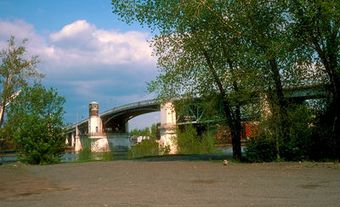Salaberry-de-Valleyfield
Salaberry-de-Valleyfield (formerly Valleyfield), Qué, City, pop 26 170 (2001c), 26 600 (1996c), 27 598 (1991c), area 27.45 km2, inc 1874, is located on the South Shore of the ST LAWRENCE RIVER, at the northeastern extremity of Lac St-François. The townsite was part of the seigneurial land granted to Charles de BEAUHARNOIS, governor of New France from 1726 to 1747. Construction of the Beauharnois Canal (1842-54) attracted many immigrants to the town. A sawmill and a large paper mill were established in the 1850s. A cotton mill (the future Montreal Cotton Company) opened 1875 and dominated the activity and growth of this small industrial city until WWII.Salaberry-de-Valleyfield draws its labour force from the local population and its history is marked by often violent labour disputes (see COMPANY TOWNS). Originally (1874) it was called Salaberry, in honour of Charles d'Irumberry de SALABERRY. Through popular usage, the name "Valleyfield" was added by the economically elite anglophone minority (in memory, it is said, of a Scottish paper mill). Served by railway since 1885, Salaberry-de-Valleyfield became an episcopal seat in 1892.
An important commercial and industrial centre, its activities today are diversified: ocean shipping, hydroelectric production, rubber manufacturing, zinc refining, chemical products, textiles and foodstuffs. Each summer it hosts one of North America's biggest speedboat regattas.

 Share on Facebook
Share on Facebook Share on X
Share on X Share by Email
Share by Email Share on Google Classroom
Share on Google Classroom

